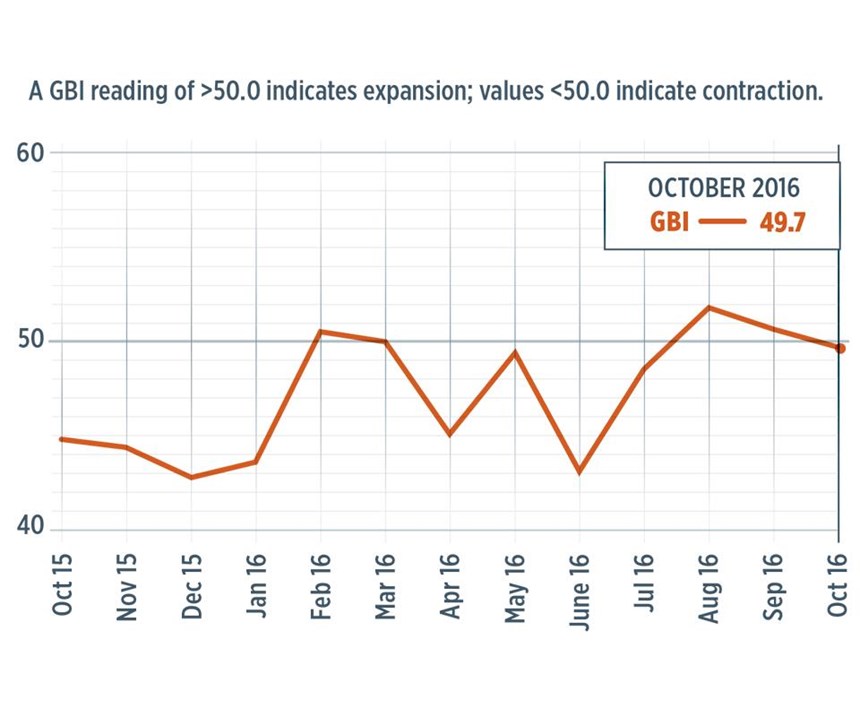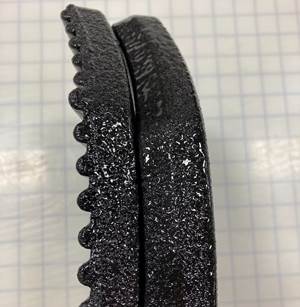Gardner Business Index at 49.7 in October
Employment is up and composites in the US electronics industry continue a 2016 growth trend.
With a reading of 49.7, the Gardner Business Index, in October, showed that the US composites industry had contracted, but did so at a very slow rate. Further, this was the first month the industry had shown contraction in the last half of 2016 since July.
The new orders subindex was just below the 50 mark, indicating new orders contracted in October after growing in the previous three months. The production subindex, however, increased for the third month in a row. During the previous three months, the production subindex had been at or near its highest level since early 2015. Meanwhile, the backlog subindex in October showed contraction again, as it had every month but one thus far in 2016. Backlogs were the primary reason that the overall index was not higher in 2016. However, the backlog subindex seemed to have bottomed out in August 2015. Employment increased for the third month in a row. Exports were virtually flat for the second time in four months. The export subindex, by October, had clearly trended up since November 2015. And supplier deliveries shortened for the first time since July 2016 and for only the fourth time since the GBI was first published in December 2011.
In October, material prices continued an upturn begun in February. But rate of increase, which peaked in August, decelerated in August and September. Prices received were unchanged in October, after its subindex had trended upward since January. The future business expectations subindex had been dropping the previous two months, but the level of the subindex remained, in October, about average for the year.
In terms of US markets served, the automotive industry contracted at its fastest rate in October since January. Since October 2015, the automotive subindex had been above 50 in only one month. The aerospace industry, in October, contracted for the second month in a row. September and October were the two weakest months for the aerospace subindex since January. Meanwhile, the electronics industry grew at its fastest rate in at least the previous 24 months. As October closed out, that subindex had shown contraction in only one month during 2016.
Regionally, the Western US grew at the fastest rate in October. The region had expanded two of the preceding three months as its subindex improved substantially after bottoming in June. The only other region to grow in October was the North Central-East, which had grown for three consecutive months. The North Central-West contracted slightly after growing in September. Also, the Southeast recorded a minimal contraction after several months of strong growth. The subindex for the Northeast had trended down since February, contracting in three of the previous four months. The South Central had contracted most of the past year.
Moving on to the manufacturers, facilities with more than 250 employees were flat in October, although their subindex was notably higher in the preceding three months. The subindex for plants with 100-249 employees was at its highest since December 2014, and had grown in seven of the previous 10 months. Fabricators with-50-99 employees also had performed well recently, contracting only twice since February. Smaller companies in 2016 had mostly contracted, but conditions for them in October seemed to be improving.
Related Content
Materials & Processes: Fabrication methods
There are numerous methods for fabricating composite components. Selection of a method for a particular part, therefore, will depend on the materials, the part design and end-use or application. Here's a guide to selection.
Read MoreMaterials & Processes: Fibers for composites
The structural properties of composite materials are derived primarily from the fiber reinforcement. Fiber types, their manufacture, their uses and the end-market applications in which they find most use are described.
Read MoreUS Air Force selects Integris Composites ballistic body armor
Cratus Wave armor is thin, lightweight and reduces heat stress, providing buoyant personal protection for the 582nd Helicopter Group.
Read MoreLockheed Martin expands development, production of ultra-high temp CMCs with facility expansion
Targeting current and future needs in hypersonic and aeronautics applications, Lockheed Martin Skunk Works’ Allcomp team is increasing and digitizing its capabilities in ceramic matrix composite (CMC) materials and parts fabrication.
Read MoreRead Next
CW’s 2024 Top Shops survey offers new approach to benchmarking
Respondents that complete the survey by April 30, 2024, have the chance to be recognized as an honoree.
Read MoreComposites end markets: Energy (2024)
Composites are used widely in oil/gas, wind and other renewable energy applications. Despite market challenges, growth potential and innovation for composites continue.
Read MoreFrom the CW Archives: The tale of the thermoplastic cryotank
In 2006, guest columnist Bob Hartunian related the story of his efforts two decades prior, while at McDonnell Douglas, to develop a thermoplastic composite crytank for hydrogen storage. He learned a lot of lessons.
Read More
.JPG;width=70;height=70;mode=crop)























